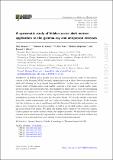A systematic study of hidden sector dark matter: application to the gamma-ray and antiproton excesses
Author(s)
Hooper, Dan; Leane, Rebecca K; Tsai, Yu-Dai; Wegsman, Shalma; Witte, Samuel J.
Download13130_2020_Article_13447.pdf (848.4Kb)
Publisher with Creative Commons License
Publisher with Creative Commons License
Creative Commons Attribution
Terms of use
Metadata
Show full item recordAbstract
In hidden sector models, dark matter does not directly couple to the particle content of the Standard Model, strongly suppressing rates at direct detection experiments, while still allowing for large signals from annihilation. In this paper, we conduct an extensive study of hidden sector dark matter, covering a wide range of dark matter spins, mediator spins, interaction diagrams, and annihilation final states, in each case determining whether the annihilations are s-wave (thus enabling efficient annihilation in the universe today). We then go on to consider a variety of portal interactions that allow the hidden sector annihilation products to decay into the Standard Model. We broadly classify constraints from relic density requirements and dwarf spheroidal galaxy observations. In the scenario that the hidden sector was in equilibrium with the Standard Model in the early universe, we place a lower bound on the portal coupling, as well as on the dark matter’s elastic scattering cross section with nuclei. We apply our hidden sector results to the observed Galactic Center gamma-ray excess and the cosmic-ray antiproton excess. We find that both of these excesses can be simultaneously explained by a variety of hidden sector models, without any tension with constraints from observations of dwarf spheroidal galaxies.
Date issued
2020-07-23Department
Massachusetts Institute of Technology. Center for Theoretical PhysicsJournal
Journal of High Energy Physics
Publisher
Springer Berlin Heidelberg
Citation
Hoope, Dan et al. “A systematic study of hidden sector dark matter: application to the gamma-ray and antiproton excesses.” Journal of High Energy Physics 2020 (July 2020): 163 © 2020 The Author(s)
Version: Final published version
ISSN
1029-8479